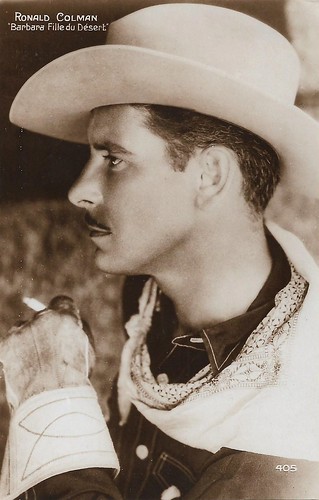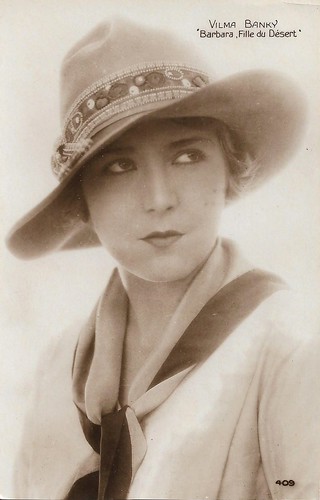
French postcard by Editions Cinémagazine, no. 405. Ronald Colman in The Winning of Barbara Worth (Henry King, 1926).

French postcard by Editions Cinémagazine, no. 409. Vilma Bánky in The Winning of Barbara Worth (Henry King, 1926).

French postcard by Editions Cinémagazine, no. 428. Photo: Vilma Banky in The Winning of Barbara Worth (Henry King, 1926).

French postcard by Europe, no. 212. Ronald Colman in The Winning of Barbara Worth (Henry King, 1926).
A catastrophic flood
Frances Marion based her film script on the novel 'The Winning of Barbara Worth' by Harold Bell Wright, which in turn is a dramatisation of the real events that gave rise to the Salton Sea in California between 1905 and 1907. As a child, Barbara (Vilma Bánky) is orphaned when her settler parents perish trying to cross a California desert. She is rescued and adopted by Jefferson Worth (Charles Willis Lane). Worth's dream is to one day cultivate the desert with his own irrigation concept and thus take away its horrors.
Fifteen years later, Willard Holmes (Ronald Colman) arrives in the area. He is the West Coast chief engineer of his unscrupulous stepfather James Greenfield (E. J. Ratcliffe)'s company. Holmes plans to divert the Colorado River so that the desert will one day be greener. Worth joins forces with him. During his task, Willard meets the beautiful Barbara and the two fall in love.
However, Willarde has a rival: another, younger man is also vying for the favour of the beautiful Barbara. The lanky, grounded cowboy Abe Lee (Gary Cooper), the foreman of her father's ranch and company, shows interest in her. In the course of the story, Abe realises that Barbara's love for him will never be anything more than brotherly feelings.
.
James Greenfield, Willard Holmes's greedy employer, meanwhile, refuses to spend the money to reinforce his gigantic water project. The river is dammed, but the developer swindles the ranchers and refuses to reinforce the weakening dam, as he no longer needs it. An angry mob turns on Worth. After the project workers refuse to continue their work, an enormous flood puts everything under water and costs many lives. This catastrophic flood is the visual and dramatic highlight of the film. Willard, in unison with Abe Lee, heroically tries to save what can be saved. Barbara is impressed by his energy. He promises to return to marry her after he has conquered the Colorado River and turned the desert into a bountiful paradise.
The Winning of Barbara Worth (Henry King, 1926) was filmed in California's Imperial Valley and in the Black Rock Desert of Nevada. The reviewer of Variety in 1925: "Taking a story of this sort and injecting, besides the author’s purport, entertainment, is no child’s task. King has performed a miraculous task. The telling of the story, of course, was the big thing. Putting over the fine points of the yarn by showing a desert sandstorm and then showing the progress of reclamation work and the destruction done by faulty construction was a mountainous job, well executed."

German postcard by Ross Verlag, no. 1794/2, 1927-1928. Photo: United Artists. Ronald Colman in The Winning of Barbara Worth (Henry King, 1926).

German postcard by Ross Verlag, no. 1794/3. Ronald Colman in The Winning of Barbara Worth (Henry King, 1926). On the card, the French title of the film is handwritten, Barbara, fille du Désert.

German postcard by Ross Verlag, no. 1795/1, 1927-1928. Photo: United Artists. Ronald Colman and Vilma Bánky in The Winning of Barbara Worth (Henry King, 1926).

German postcard by Ross Verlag, no. 1795/3, 1927-1928. Photo: United Artists. Ronald Colman and Vilma Bánky in The Winning of Barbara Worth (Henry King, 1926).

German postcard by Ross Verlag, no. 1795/4, 1927-1928. Photo: United Artists. Ronald Colman and Vilma Bánky in The Winning of Barbara Worth (Henry King, 1926).
Sources: the Giornate del Cinema Muto 2024 (Italian), Variety, Wikipedia (English, German and French) and IMDb
No comments:
Post a Comment